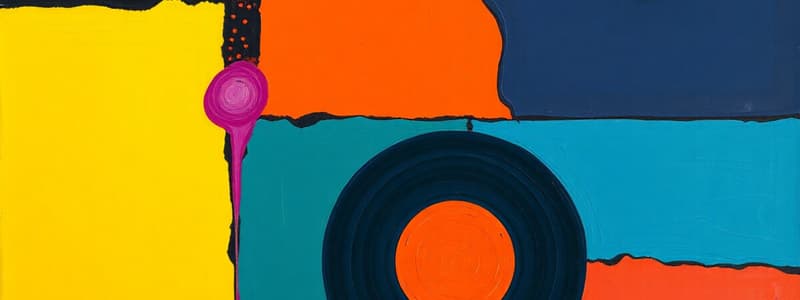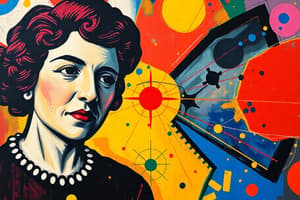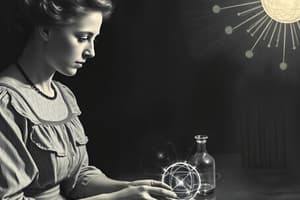Podcast
Questions and Answers
What was Lise Meitner's primary contribution to the discovery of nuclear fission, as described in the provided text?
What was Lise Meitner's primary contribution to the discovery of nuclear fission, as described in the provided text?
- Independently discovering nuclear fission and publishing the findings prior to Hahn's experiment.
- Leading the research team in Copenhagen that experimentally confirmed the nuclear fission process.
- Conducting the initial experiment in 1938 that demonstrated the splitting of the uranium nucleus.
- Developing the theoretical explanation of Hahn's experimental results, applying Einstein's theory of relativity. (correct)
Which principle from Einstein's theory of relativity was crucial to Meitner's explanation of nuclear fission?
Which principle from Einstein's theory of relativity was crucial to Meitner's explanation of nuclear fission?
- The principle of equivalence between gravity and acceleration.
- The relationship between mass and energy ($E=mc^2$). (correct)
- The concept of spacetime curvature due to mass and energy.
- The constancy of the speed of light in a vacuum.
Which sequence of events accurately represents the process of nuclear fission as described in the text?
Which sequence of events accurately represents the process of nuclear fission as described in the text?
- Energy release → formation of new nuclei → neutron bombardment → nucleus division.
- Nucleus division → neutron bombardment → energy release → formation of new nuclei.
- Neutron bombardment → nucleus division → formation of new nuclei → energy release. (correct)
- Formation of new nuclei → energy release → nucleus division → neutron bombardment.
What inference can be made about the relative masses of the components involved in nuclear fission, based on Meitner's explanation?
What inference can be made about the relative masses of the components involved in nuclear fission, based on Meitner's explanation?
According to the timeline presented in the text, when did Meitner and Frisch publish their joint findings on nuclear fission?
According to the timeline presented in the text, when did Meitner and Frisch publish their joint findings on nuclear fission?
Which of the following best describes the relationship between Meitner, Hahn, and Frisch in the discovery of nuclear fission, as portrayed in the text?
Which of the following best describes the relationship between Meitner, Hahn, and Frisch in the discovery of nuclear fission, as portrayed in the text?
Considering Meitner's statement, 'Science can bring both joy and satisfaction to your life,' how does it contextualize her experience regarding the Nobel Prize omission?
Considering Meitner's statement, 'Science can bring both joy and satisfaction to your life,' how does it contextualize her experience regarding the Nobel Prize omission?
Based on the text, what was the immediate, impactful consequence of the discovery of nuclear fission?
Based on the text, what was the immediate, impactful consequence of the discovery of nuclear fission?
Flashcards
Nuclear Fission
Nuclear Fission
The process in which a nucleus splits into smaller nuclei, releasing energy.
Lise Meitner
Lise Meitner
A physicist who contributed to the understanding of nuclear fission but was overlooked for the Nobel Prize.
Otto Hahn
Otto Hahn
The scientist awarded the Nobel Prize in 1944 for the discovery of nuclear fission.
Einstein's Theory of Relativity
Einstein's Theory of Relativity
Signup and view all the flashcards
Neutron Bombardment
Neutron Bombardment
Signup and view all the flashcards
Mass-Energy Conversion
Mass-Energy Conversion
Signup and view all the flashcards
Copenhagen Laboratory
Copenhagen Laboratory
Signup and view all the flashcards
Joy and Satisfaction from Science
Joy and Satisfaction from Science
Signup and view all the flashcards
Study Notes
Science and Objectivity
- Science strives for truth and objectivity.
Nuclear Fission
- Meitner and Frisch, in 1938, explained nuclear fission.
- Nuclear fission occurs when a nucleus is bombarded with a neutron.
- This process results in the splitting of the nucleus, releasing a large amount of energy.
- The mass of the new nuclei is less than the original nucleus.
- This "lost" mass converts to energy as per Einstein's theory of relativity.
- Hahn's 1938 experiment was crucial in understanding fission.
- The discovery spread quickly and led to the development of the atomic bomb.
Lise Meitner
- Meitner worked with Otto Hahn to understand nuclear fission.
- She highlighted the significance of mass-energy conservation in the process.
- Her crucial role in the discovery was not recognized for decades.
- She remained dedicated to science, emphasizing its value in bringing joy and satisfaction to life.
Studying That Suits You
Use AI to generate personalized quizzes and flashcards to suit your learning preferences.




